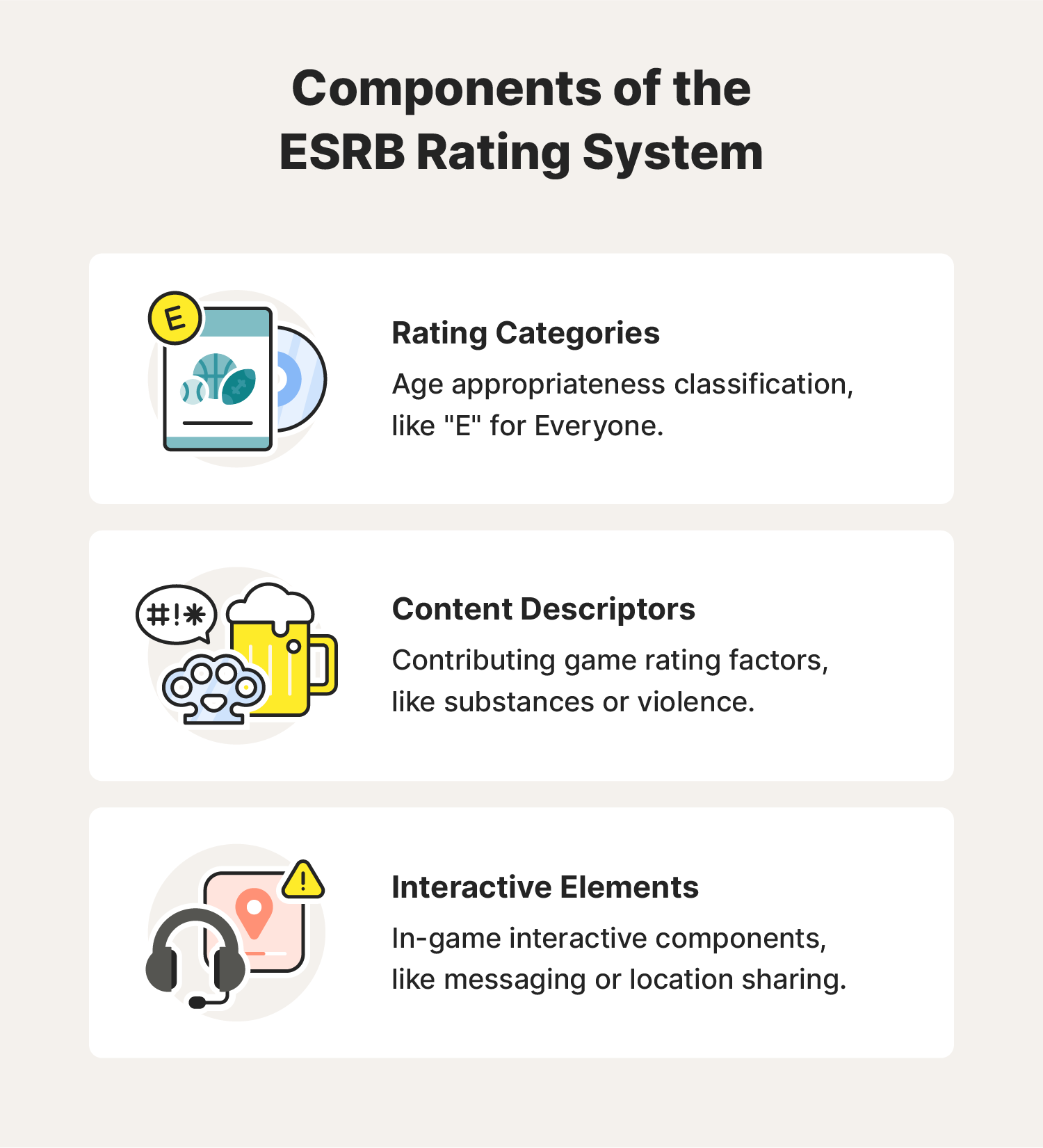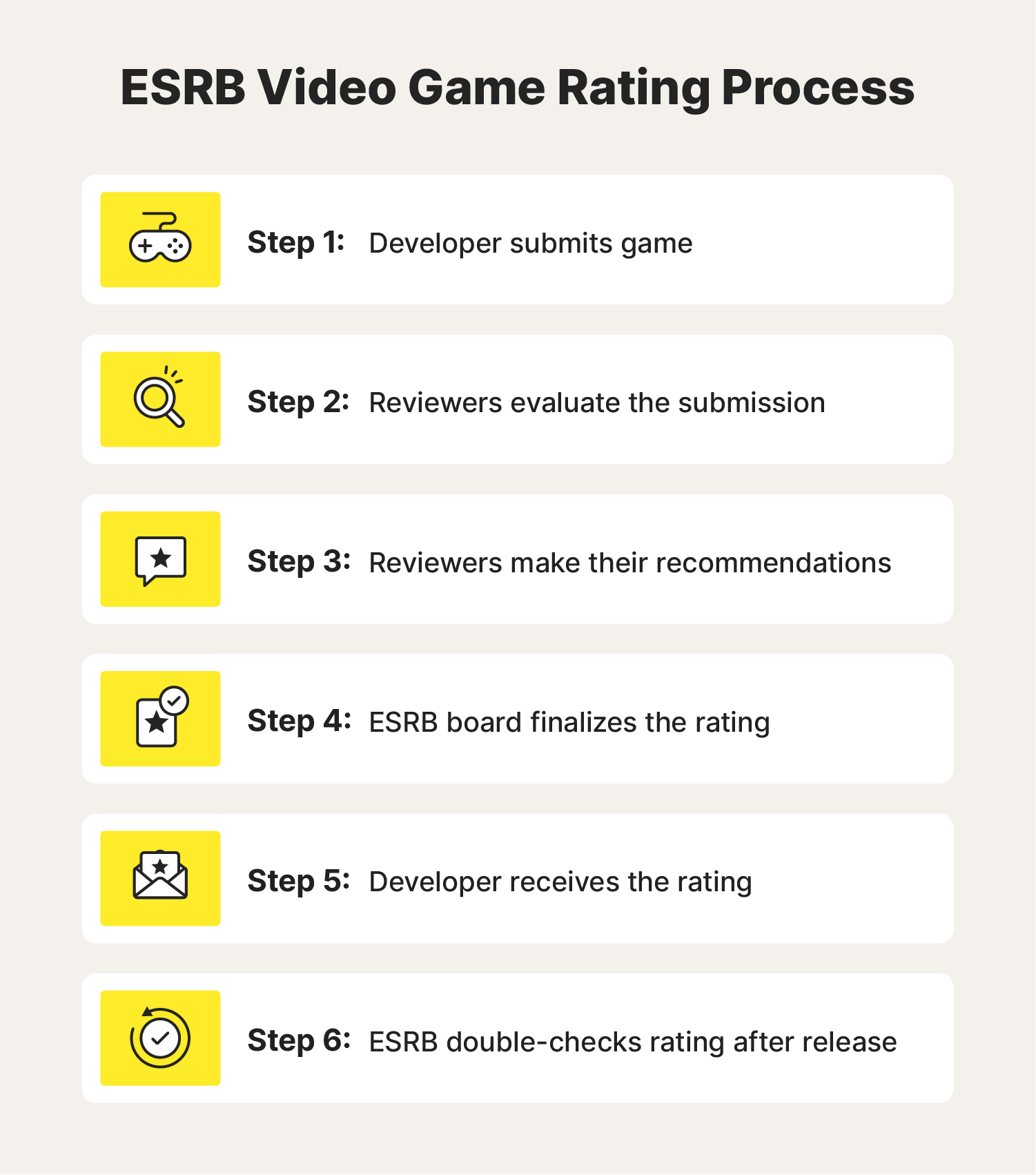Video game ESRB ratings: Are your kids’ games age-appropriate?
If you’re worried about the experiences your kids are having while gaming, video game ratings can help you determine if the content of their games is appropriate. Keep reading to learn about the video game rating system and how using Norton 360 for Gamers can help you protect your kids as they immerse themselves in exciting virtual worlds.

Movies, albums, and TV shows have them, so it should come as no surprise that video games have a content rating system, too. In the U.S., the Entertainment Software Rating Board (ESRB) assigns age and content ratings to handheld, console, and computer games and apps—and has been around since 1994.
Originally created in response to concerns about violent and sexual content in video games, the ESRB now rates thousands of video games each year. These video game ratings help parents gauge the content of video games and decide what’s appropriate for their children.
What is the ESRB video game rating system?
The ESRB video game rating system includes Rating Categories and Content Descriptors so parents can decide if a game is suitable for their kids. The ESRB also highlights any Interactive Elements to be aware of. As an impartial and standardized video game rating system, it helps ensure consumers in the U.S., Canada, and Mexico have the information they need to help protect their kids from inappropriate content.


ESRB Rating Categories
An ESRB rating category suggests the level of maturity needed to play a specific video game. “E” (Everyone) is by far the most common category, accounting for 47% of all ratings in 2023; the second biggest category was “T” (Teen) at 23%.
Here’s our ESRB video game rating chart containing the different classifications and an overview of why games earn these ratings:
Everyone
Video games rated “E” for Everyone have content that is generally suitable for all ages. E-rated games may include some minimal cartoon or fantasy violence and occasional strong language.
- Popular video games rated E: Animal Crossing, Fall Guys, and Mario Kart
Everyone 10+
Video games rated “E10+” are typically for gamers who are 10 years old and up. Games with this rating may include a bit more cartoon or fantasy violence as well as stronger language and suggestive themes.
- Popular video games rated E10+: Just Dance, LEGO® Brawls, and The Legend of Zelda: Tears of the Kingdom
Teen
Video games rated “T” for Teen are suitable for gamers aged 13 and up. Games may include elements of violence, suggestive content, minimal blood, crude humor, simulated gambling, and occasional strong language.
Popular video games rated T: Apex Legends, Fortnite Battle Royale, and Roblox
Mature 17+
Video games rated “M” for Mature 17+ are suitable for 17-year-old gamers and up. M-rated games may feature intense violence, blood and gore, strong language, and some sexual content.
Popular video games rated M: Call of Duty®: Warzone™, Dead Island 2, and Red Dead Redemption
Adults Only 18
Video games rated “AO” are meant for Adults Only, meaning 18-year-olds and up. AO-rated games may contain graphic and prolonged instances of violence or sexual content, and real gambling.
- Popular video games rated AO: Grand Theft Auto: San Andreas, Hatred, and Seduce Me
Rating Pending
Video games rated “RP” for Rating Pending have been submitted for review but not yet assigned a rating. Video games can earn an RP rating before they’re released and while they’re being advertised and marketed, but many stores won’t stock the game until they receive a score.
Rating Pending—Likely Mature 17+
Video games that are likely to be rated Mature 17+ but are waiting for an ESRB rating are slotted into this temporary category. As the newest video game rating, it was introduced to help buyers make decisions, especially when developers are only accepting pre-orders.
ESRB content descriptors
The ESRB uses more than 30 content descriptors to describe what’s in a game. When a content descriptor is labeled “Mild,” it signifies low frequency, intensity, or severity. The descriptors fall into eight categories:
- Blood and gore: Animated blood, realistic blood, or mutilation is present in the game.
- Gambling: Real or simulated gambling, or themes associated with real-world gambling, can be found in the game.
- Humor: The dialogue contains comic mischief like suggestive comedy, adult humor with sexual overtones, or crude “bathroom” humor.
- Language: Characters use profanity, or the in-game music contains swearing, sexual references, violent themes, or mentions of drug and alcohol use.
- Nudity: Characters appear nude or semi-nude.
- Sexuality: The game shows sexual behavior (explicit or not), sexual violence, materials regarding sexuality, or is generally provocative.
- Substances: Alcohol, tobacco, or drugs are used or referenced.
- Violence: The game may show violence in a fantasy context, intense violence, aggressive conflict, or contain violent references.
Interactive elements
The ESRB’s Interactive Elements help parents understand in-game engagement or online features. This allows them to ensure their kids aren't inappropriately communicating with strangers, running up a credit card bill, or sharing their location. Here are the interactive components the ESRB highlights:
- In-game purchases: Can players make in-game purchases with real-world currency?
- Location sharing: Can other players see your physical location?
- Unrestricted internet access: Does the game allow unrestricted internet access (e.g., search engines and browsers)?
- User-to-user communication: Can players communicate openly with little oversight or few restrictions, and share media?
- Unrated songs: Can songs be downloaded or streamed within the game, meaning they won’t be rated by the ESRB?
How are video games rated?
The video game rating process differs slightly depending on whether the video game exists solely as a digital download or is available as a physical (boxed) product.
In either case, the overall review process usually follows this general outline:
- The video game developer submits a questionnaire and a highlight reel of the game’s most extreme content.
- Three specially trained reviewers analyze the submitted materials to identify any questionable themes in the gameplay, cutscenes, and other content.
- The raters recommend a Rating Category, Content Descriptors, and Interactive Elements.
- The ESRB board considers the raters’ recommendations and confirms the final Rating Summary.
- The game developer receives the rating and can choose to accept it or revise the game to get a different score.
- After a video game is released, an ESRB rater may play some of it to ensure the previously assigned video rating is accurate.


How important is it to check the ratings on my kids’ video games?
Checking video game ratings before your kids play is vital for ensuring the game is appropriate for their age and maturity level. Often, games cannot be accurately assessed simply by their title, artwork, or marketing materials, so an ESRB rating offers an easily digestible, comprehensive evaluation.
Ultimately, ratings allow you to make informed decisions that protect your child from content that may not be developmentally suitable or aligned with your family’s values. If children are exposed to certain themes before they’re ready, it could lead to aggressive behavior, behavioral issues, trouble socializing and paying attention in school, and sleep problems.
Take over the controls
While video game ratings offer valuable guidance, even age-appropriate titles aren’t always risk-free. Norton 360 for Gamers provides an extra layer of security for families, protecting against malware and other online threats kids might face while gaming. Plus, it comes with a suite of Parental Controls‡ to ensure your child plays by your rules.
‡Help your kids; manage their online activity, and identify potential dangers before they become a problem.
Editorial note: Our articles provide educational information for you. Our offerings may not cover or protect against every type of crime, fraud, or threat we write about. Our goal is to increase awareness about Cyber Safety. Please review complete Terms during enrollment or setup. Remember that no one can prevent all identity theft or cybercrime, and that LifeLock does not monitor all transactions at all businesses. The Norton and LifeLock brands are part of Gen Digital Inc.





Want more?
Follow us for all the latest news, tips and updates.